The Legend of Ki Tora
- by Kelvin Miyahira
French Translation by Robin Cocq - CLICK HERE!
On a remote island off the coast of Japan, there is a legendary golfer named Ki Tora........
Whack! He slams shot after shot over 330 yards on the fly. With perspiration beading off his face, he wipes it with his shirt sleeves and continues to strike it solid and far. Deep in the forest, the deafening silence is broken only by the thunderous collision of hard rubber and metal meeting at over 130 miles per hour. The impact of the ball and the whizzing of the ball streaking out into the distance are like no other golfer on the planet. Legend has it that Tora sleeps only three hours a night so that he can maximize his practice hours in a day. He can hit 1000’s of golf balls in a day and that’s after a hard early morning workout to keep his rock hard, sculpted “V” shaped body in the condition reminiscent of a young Arnold Schwarzenegger.
Tora is fascinated by modern ways to train using high technology. With billions of dollars in resources to be creative, his practice routine is limited only by his imagination. He once sent his private jet to pick up baseball pitcher Tim Lincecum and flew him to his remote practice area to pitch golf balls at him at 100 mph to allow him to refine his already supreme hand eye coordination. He once hit one of these pitches out of the park despite his expansive practice facility’s fence being over 400 yards away! And that was with his a 4 iron! Ronaldinho once arrived with a dozen soccer balls. He kicked 100’s balls at the goal from penalty kick range and was never able to score against Tora armed only with a 9 iron. Angrily, he left with a parting shot to Tora’s face leaving a scar and a chipped tooth that remains to this day. The great One, Wayne Gretzky could not score against Tora either. He was so upset that he demanded to know what secrets Tora had that might allow him to make a comeback to the NHL.
Tora did divulge a secret weapon for golf. After training with Navy Seals and Marines, he was told of a supercomputer combined with high technology that could help him with his golf game. It was the Stealth B1 bomber of technological marvel combining the abilities of MRI that can see through walls of steel and titanium combined with the sonar/radar capability of a Great White Shark. This incredible machine could tell Tora everything he wanted to know about what position the club was in at impact with unbelievable accuracy. Costing millions of $$$’s, Tora wasted no time in obtaining this covert military technology. The only drawback to this technology was the complexity. He was not capable on his own to interpret the results therefore how was he going to be able to operate the supercomputer needed to direct his golf swing?
Luckily, he was soon told of a genius who worked with the supercomputer when he was in a foreign country. He was a little known guru, who looked the part. Short man a little like Mr. Peabody and Yoda mixed together. He spoke with such authority, mentioning biomechanical terminology and Zen sayings that he’d invented and how it created power in the golf swing. “I must have him!” Tora exclaimed. Alas, that was the beginning of the end. His arch enemies in Scotland and Ireland were beginning to catch up. Soon they would dominate the world. He hated McRory and McGraeme for who they were. A pint of ale each night makes you fat and lazy he thought. They would never catch him. So off Tora went in search of a guru. In Canada, he found him.
Shintaro Fori the only man in the world with knowledge of how to operate the supercomputer was brought in. Fori-sama (sama is a Japanese term only used for gods, emperors and teachers) was brilliant. But he cautioned to Tora, “You must get worse before you get better. Be patient and the world will be yours to dominate once again.” Tora was excited! His heart was pumping at the thought of world domination once again.
But that was over a decade ago. The greatest player of all time that once played to an incredible +10 handicap lost his nerve and contracted a rare form of BGS or bipolar golf shot disease. On the one hand he hits the kamikaze shot. The kamikaze shot is a shot that takes off left and dives down sharply left before crashing. The flip side of the kamikaze shot is the F-22 shot. It resembles the fast takeoff like a fighter jet but this time it sharply rises and veers right. This affliction has Tora’s head spinning and has left him in frantic search to find his true self again.
Fori-sama, the all-knowing, all-powerful guru with the insight into the complex club data spoke in terse, cryptic fashion. “Fight hook, keep clubface open longer and close faster.” Each time Tora would hook the ball, Fori-sama would repeat what he said previously. Tora, upset with the lack of progress burst out, “how in the world can I stop from hooking if I close the clubface faster?!!”
“Ahhhh, my son, the gear effect you must use.” Fori-sama said. “A faster closing you must perform in order to make ball fade more.”
“That’s the ticket!” Tora thought. This is the key to my hooking.
But that solution was only appropriate for his kamikaze shot (the hook). So this time Tora asked how he could stop hitting the high spinning push fade. “Swing left you must do.”
“Yes, that’s the answer” he mused to himself. “That’s the reason I push it right.” So off Tora went happily skipping back to the range.
Meanwhile back in the Ireland, McRory having learned his lesson last year about listening to biomechanical experts, went back to work with his old teacher, Ian McRoc who lived in Rocderry. The venerable old man was very old school. He still believed in old technology like video cameras and classic ball flight laws but with one exception, he knew that the swing was dynamic. Therefore the clubhead movements through impact were dynamic and potentially volatile so he taught McRory about clubface stability in the impact zone. Soon McRory began playing better and winning again.
Since McRory felt sorry for his arch nemesis Tora since they did share the love for the Greek god Nike, he asked his old teacher about what he thought of Tora’s swing changes and the use of technology. McRoc said, “MRI is just a static event for now. Technology has not improved to where we can see ultra high speed MRI video of the club’s movement in the impact zone and its effect on the direction of the shot. How can one know about dynamic things from static?” McRoc asked. After all, Rocderry was named after a famous phenomenon called Rate of Closure hence the acronym ROC. In Rocderry, a high ROC means tendency to hook and a low ROC means more of a tendency toward hitting straight or a fade.
“In America, the land of high technology still has not developed a way to see the ROC”, McRoc said.
And that is Tora’s problem.
Static vs Dynamic
According to staticicians, the club numbers game is simple. According to Trackman, 85% of where the ball flies is due to clubface angle at the static point in time termed “max compression.” Though they have been hedging their bets recently to decrease that number, I’m not sure if they’ve changed their algorithms. Hit up more, hit down more, swing more left, swing more right, close the clubface more, open the clubface more, decrease dynamic loft, plane steep, plane flat, attack angle too shallow or too steep, etc., etc., etc.
Staticicians are brilliant teachers with an enormous amount of knowledge of static conditions that they say this is simplifying the game, that number altering is easy AND most importantly repeatable. But is it? Why is Tiger hitting double-crossed hooks and draws when he’s trying to hit fades? What information are they missing?
High Tech Gear for Staticicians
Foresight HMT is a nice piece of technology for staticicians that actually measures the actual static impact conditions of the club with high speed cameras at 6000 frames per second. This should make the Trackman obsolete but it won’t. Here’s why.
This is a case example from Alex Saary in the UK. If you’ll see the screenshot below, guess where the ball went?
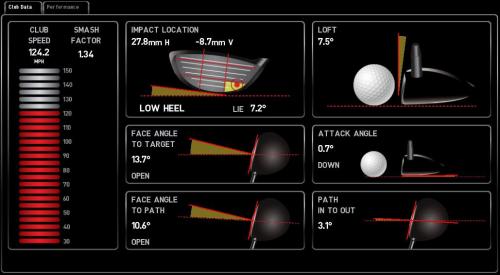
You have the clubface 13.7 degrees open with a path 3.1 degrees to the right. The impact location is way on the heel so if you have a hugely open face and a heel strike causing a gear effect (more on this later), the ball should have been a big push slice right? Wrong! The ball went 40 yards left. A big pull hook was created.
So what happened? With a static view of reality, you are clueless as to why the pull hook occurred. Bumble bees shouldn’t be able to fly right? Let’s try to figure this out.
So here’s the same golfer hitting it 300 yards with a small push draw that finished 10 yards right of target.

The clubface is actually open at initial contact by 6.6 degrees with the path 2.2 degrees to the right (4.5 degrees open to the path) yet the ball still had a small draw. But this time, the contact was only 1.2mm toward the heel. What’s going on?
In Search of Real Ball Flight Laws
I spoke to a brilliant physicist last year in an attempt to understand why the ball flies where it does. I explained to him the apparent discontinuities with old and new ball flight laws. I also asked him about how we could reconcile the differences between Phantom high speed video vs. popular radar ball tracking devices. Since he’s a non-golfer and does not have a stake in it, he saw clearly with no bias what was involved in figuring out this complex problem. He started with this:

“First, we have a collision between two spherical surfaces. The ball is struck and deforms.” Then he asks, “What is the face of the club doing?” When I said that the clubface was also deforming and rebounding (trampoline effect), he said, “you’re never going to be able to calculate this. You have to have a uniform surface, with a uniform density and a uniform deformation of the clubface.” I see.
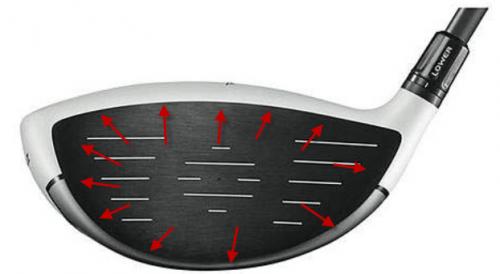
Uniform surface is somewhat possible. They could make a flat face driver. Uniform density is impossible unless you want to give up those extra yards from the trampoline effect. The edges of your driver head are designed to be denser than the center in order to create the higher coefficient of restitution.
But this makes for non-uniform deformation of the clubface with a driver. Unless they make a driver with a perfectly round clubface and the contact is in the sweet spot the size of pinhead, the chances of figuring out real ball flight laws that can be applied to all shots, not just sweet spot shots is virtually impossible. Does that mean we should give up and accept current ball flight laws which are oversimplified equations with static conditions?
Daring to Complicate Impact Interval Events
Gear Effect and Club Design
From Dave Tutelman’s site. See picture below. With center of mass near front of the clubface, there’s no gear effect on irons and with center of mass farther back on driver/woods, there’s going to be gear effect. Thus on a toe contact the ball will tend to draw while the heel contact tends to fade.

But golf club technology is ever changing and can have a big influence on how the ball will fly.

So what’s going to happen with these deep undercut soled irons from Callaway? Is there going to be a gear effect on irons since they’ve shifted the center of mass farther back from the clubface??? Maybe manufacturers know the answer.

From Taylormade’s commercial, the new SLDR driver and fairway woods are designed with the center of gravity way farther forward and lower to produce a driver with a high launch angle and lower spin rate. Better yet, these clubs will play more like muscle back irons (center of mass forward means it has little or no gear effect) on off-center hits. From what I’ve seen, this makes these clubs hit straighter, longer and with less spin than any other driver on the market.
Now that you know that there are differences between clubs, how do you know if the gear effect is at work or something else? Do you even know where the center of gravity is with your current driver? Forward or back?
Revisiting the Gear Effect study
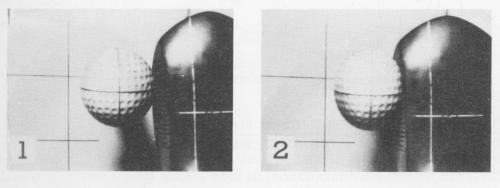
Here are the original pictures for the gear effect patent from Spalding Co. using a flat-faced club. Supposedly the pictures show a toe hit that rebounds the clubface open and causes a draw. But upon closer review………………………………
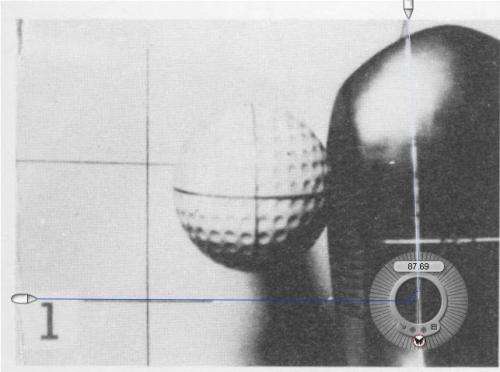
When comparing the line on the grid below the ball and the line on their club, it appears to be closed by a little over 2 degrees! Note: if square, the protractor should read 90. Since it reads 87.69, you can subtract that by 90 and you get -2.31 degrees. In other words 2.31 degrees closed.
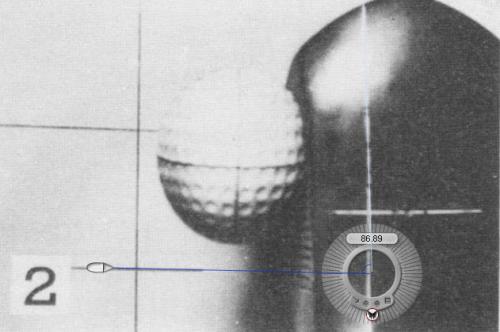
By picture 2 the clubface closed to a little over 3 degrees! Thus, the club closed over a degree while club in contact with ball.
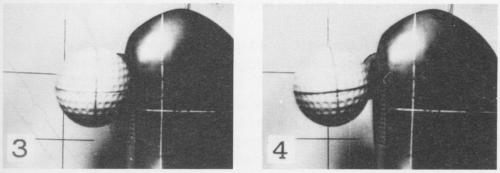
Sure the clubface opened by picture 4 but if the clubface was closed by at least 3 degrees at max compression the ball should draw left not because of some phantom (pun intended) gear effect but because the clubface was closed!
Doesn’t this cast a huge shadow on the gear effect? Realize that this might be Marketing 101 and that this was Spalding’s way of saying “we make better golf clubs with bulge and roll due to our knowledge of the newly discovered gear effect.” There’s nothing wrong with marketing a product, but let’s not make the mistake of believing that marketing = science.
But for more than 70 years now, practically everyone in the golf industry has been side tracked by this dubious notion. I am highly skeptical for I have seen Phantom videos that show differently.
Gear Effect Fallout: Rate of Closure
If you believe in the gear effect it presents some intuitively contradictory conclusions. The scibusinessmen (scientists marketing products or marketing people taking constructs of science to sell product) would have you think that:
- Heel shots fade while toe shots draw
- Faster closure = fade and a lower closure rate = draw.
Actually neither is ALWAYS true. It still depends on some other factors.
Any golfer that’s hit a wild duck hook senses that it is not caused by a low rate of closure. It is caused by a high rate of closure!

How did Bubba Watson hit his gap wedge with a 40 yard hook to win the Masters two years ago? Low rate of closure? I think not. To even present the information in this static way is a bit of a stretch. Here’s another odd conclusion.
Faster rate of closure = fade/slice to gear effect believers
OR
Faster rate of closure = draw/hook to non-believers of the gear effect
Did Bubba roll his clubface faster or slower to create his 40 yard hook with a gap wedge?
So my theory of rate of closure would be the opposite. A high rate of closure would generally promote a hook (heel shots contribute to a higher closure rate) and a low rate of closure (toe shots contribute to a lowered closure rate) would promote a fade.
Vertical Gear Effect
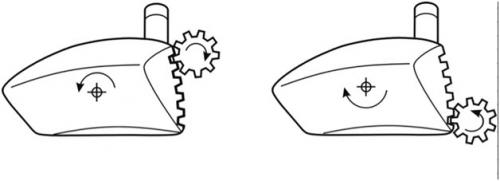
What about vertical gear effect you say? From Wishongolf.com, here’s an illustration of how contact high on the face causes overspin while low face contact creates backspin. Supposedly the clubface will rapidly rotate around center of gravity of club thus creating an opposite spin.

But is there another possible explanation for this phenomenon? Remember the non-uniform face density? The non uniform deformation of the clubface could cause decreased spin on high on face contact and the opposite for low on face contact. But since you can’t calculate the effect of this at this point in time, I guess this will be challenged vehemently by those that like to create spherical cows.
See the two different clubface contacts below.
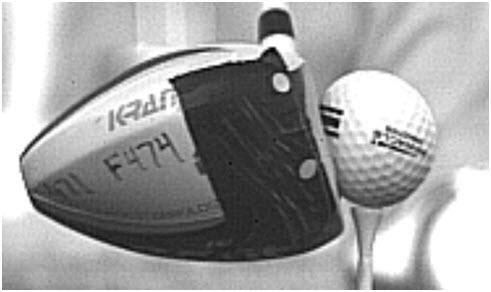
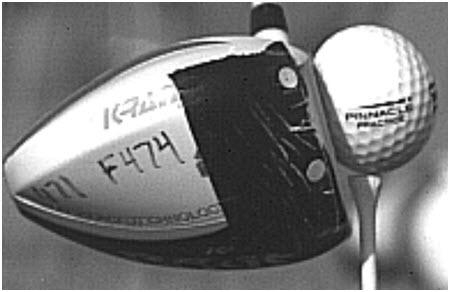
What about Dynamic Angle of Attack?
According to spherical cow scientists, the clubhead will ALWAYS be deflected downward upon impact. They can even calculate this. Really??? World class long driver Tyler Kellett shows this just ain’t so. Could this be an effect of parametric acceleration as well? Hmmm, there must be a force directed upward/inward in order to inhibit the downward deflection of the clubhead………………………
All things being equal, the lower contact on the face and more diving down of clubhead at impact will result in more spin just as is the case with the low spinning wedge. The higher on the clubface contact is and with the clubhead is deflected upward, there will be less backspin.
Available Science
So the search continues and it seems the available science is not interested in golf balls hit by real people.
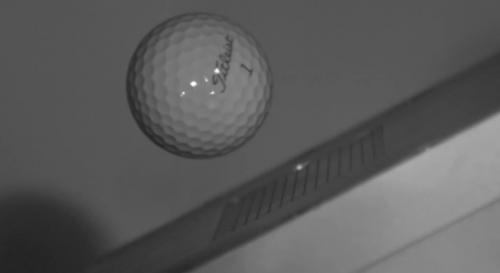
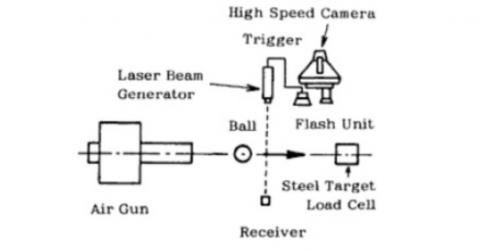
The available science on spin rate and ball flight is still in its infancy. It seems that much of the research is only interested in backspin rate or spin in the vertical plane. Thus much has been done using air guns shooting golf balls at a rigid steel plate. This simplifies ball contact by removing many key elements of the club’s rate of closure, dynamic path changes, dynamic loft changes, dynamic angle of attack and more. By removing these key elements the researchers have created the spherical cow.
Also, a solid steel block does not deform nor have trampoline effect like the clubface on a titanium driver. Do they even test with bulge and roll of driver face? So how will the real impact conditions differ from the laboratory uniform spherical cow conditions? Maybe only club manufacturers know the answers?
http://iiav.org/archives_icsv/2008_icsv15/Papers/T0446.pdf
Shooting balls at stationary steel plates can also cause scientists to focus on friction. See this study uses decades old idea of the ball either sliding or rolling up the clubface when Phantom videos clearly show this is not the case. Thus complex mathematical calculations are made based on a false premise.
From Biomedical Engineering in Sports

Club manufacturers use robots to test different impact locations and where the ball will be launched at based on impact location. The “R” means right and “L” means left. So if you’re promoting “new” ball flight laws yet leave out important details like this, how ACCURATE are you likely to be?
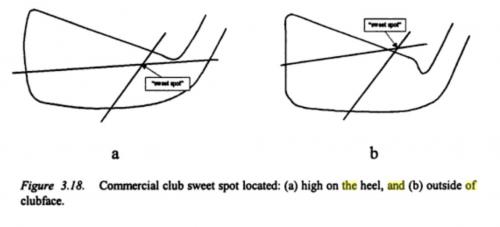
Here’s an interesting diagram of an iron’s sweet spot. If sweet spot is off the clubface as in figure b, how is anyone going to hit it??? Does that mean that all shots struck with irons have bad data (since radar people say only sweet spot impact is valid) as calculated by radar launch monitors? Do you see how Ki Tora could be very confused now?
D Plane or Dynamic Collision
The D Plane is but a static notion of the impact conditions. Not that there’s anything wrong with that…………………….but it does leave out rate of closure, path deflection/shifts and the effect of off center strikes (99.99% of shots are not struck on the tiny pin head sized sweetspot). So we know there’s a lot to be desired in terms of our understanding of ALL the phenomena that influence where the ball is going to fly.
So what else might be involved in the dynamic collision between ball and clubhead?
- Rate of Closure
- High
- With a high rate of closure the toe of the club is moving faster than the center of clubface by 7 or more mph
- Low
- Negative
- A slicer can have the heel moving faster than the toe.
- Anywhere in between
- High
- Contact location affects rate of closure
- Dependent upon club design and center of gravity location
- Heel strikes close the clubface faster
- On muscle back or blade clubs it tends to cause draw
- On large cavity back clubs it tends to cause fade
- Toe strikes open the clubface or slow closure rate.
- On muscle back or blade clubs it tends to cause fade
- On large cavity back clubs it tends to cause draw.
- Low contact delofts the clubface during impact interval thereby lowering launch angle
- High contact adds loft thus increasing launch angle
- Contact of the ball nearer the denser edges of the club will deform golf ball in a way to create spin. For woods/hybrids ONLY:
- Heel edge strikes can cause more fade spin
- Toe edge strikes can cause more hook spin
- Low on the face contact generates more backspin
- High on the face contact will create less backspin
- Dynamic path during impact interval
- https://www.youtube.com/watch?v=j8BHuZC0RpA
- Path can shift left
- Can increase slice spin or pull
- Path can shift right
- Can increase hook spin or push
- Path can continue
- Deformation of Clubface
- Always deforms more toward center of the clubface
- Unknown what this will do to ball flight
- Initial thoughts are that the face will rebound and eject the ball slightly to the opposite direction of harder edge contact
- Dynamic Angle of Attack
- (repeat from earlier)
- Shift down creates more spin and lower launch angle (as we have seen with wedges)
- Shift up creates less spin and higher launch angle
- Stay constant
- Dynamic Dynamic Loft (That’s right. Needs to be said twice)
- Dynamic loft can be increasing
- This increases launch angle
- Decreases spin
- Dynamic loft can be decreasing
- Decreases launch angle
- Increases spin
- See video http://youtu.be/AmdIC8TH7wU
- Dynamic loft can remain constant
- Dynamic loft can be increasing
- Dynamic lie angle of club
- https://www.youtube.com/watch?v=BXBrIayM4QY
- Increasing toe up will have face more closed with less loft
- Decreasing heel up will have face more open with more loft
- Clubhead speed
- Higher speed increases spin
- Increase curvature
- Deforms ball more
- Lower speed decreases spin
- Decreases curvature
- Deforms ball less
- Higher speed increases spin
- MOI
- Resistance to twisting open on contact will be high.
- Resistance to twisting open contact will be low.
- Center of Gravity of club (Jury is still out on the gear effect)
- Forward toward face?
- Back away from face?
- Shaft interactions???
- Shaft kicking out away from player
- Shaft droop
- Related to dynamic lie angle
- Shaft torque
- Bulge and roll of driver
- Not all drivers have the same amount
- Environmental variables
- Wind
- Temperature
- Humidity
- Deformation of the ball
- Different ball compositions will create different deformations and spin rate
- The aggregate of all the aforementioned factors will ultimately deform the ball in some way that will give launch direction, launch angle, spin rate and spin axis (left or right)
- Balanced deformation with center of gravity of club moving through center of mass of ball = straight shot but not the only way to hit it straight
- Given all the variables, a straight shot can be hit in an infinite number of ways by altering the variables and balancing deformation.
- All imbalanced collisions will result in an offline shot with different amounts of side spin on ball. Of course we already know there are infinite amounts of ways to hit it crooked.
- If the toe side deforms more and eccentric force (will be explained later) is applied to toe side of ball, there will be hook/draw spin.
- If the heel side deforms more and eccentric force is applied to heel side of the ball, there will be fade/slice spin generated.
Given the true dynamic nature of the collision of ball and clubface plus all these variables (there could even be more), how are we to come up with ball flight laws? This is impossible. You want some simple equation like ball goes 85% in the direction of the clubface? Not going to happen in a million years.
How do we use static information to teach or learn?
Trackman vs Foresight HMT
So let’s say Ki Tora hits a huge hook with the 13.7 degree open clubface but this time instead of the Foresight HMT you were using a Trackman. What might the data show on Trackman? Let’s say it shows 6 degrees closed face with path 3 degrees right. What’s the fix?
So if you open the face by 9 degrees than the last shot, then you’ll have the clubface match the path so you can get a straight shot. Isn’t that logical?
But if the reality was that the clubface was open by 13.7 degrees and Ki Tora could adjust his static clubface position with some accuracy, wouldn’t his next shot be 22.7 degrees open? What if this time he struck it in the middle of the clubface? Then that ball will fly into the next county.
What to do with Foresight?
I don’t know how anyone would comprehend such a ball flight given the static impact conditions and without any knowledge of dynamic events. Perhaps recheck the camera alignment, recalibrate? Ignore such a shot?
But this shot does give clues as to the player’s inherent rate of closure.
With this release style of flip/roll combined with his high clubhead speed, you know his closure rate is extremely high. That’s why even a small draw shot from this player is hit with the clubface arriving 4.5 degrees open to the path. Does that mean a straight shot for this player needs to have an open face of 5ish degrees to path?
Thus there are some variables that are controllable by the golfer while others are purely based on club and ball design. So if we focus on what we can control, how many things can we do to make hitting the ball straighter and more consistent? Quite a lot. But first let’s try to understand the mechanism that really creates ball flight and curvature.
Dynamic view: Imbalanced collision of a hook
Here’s a phantom video of a different golfer that hit a big hook on a similar open-faced heel shot.

Here’s a diagram from Doug Marsh, engineer and critical thinking biomechanist on how the hook is accomplished.

Maybe eccentric force can explain why the ball flies where it does?
Here’s another massive hook. So let’s take this idea of eccentric force to this example.
Or here’s a slice with a negative rate of closure.
Truth about hitting a Straight Shot
In order to hit the ball straight there must be a centric force applied horizontally. That means the force must be directed at the center of gravity (COG) of the ball WHILE also balancing the deformation or compression of both heel and toe sides of the ball! In addition, if you want the ball to go straight at your target, that centric force must be directed at the target or you could get a straight ball that is left or right of target. Sounds simple enough?
Balancing Act
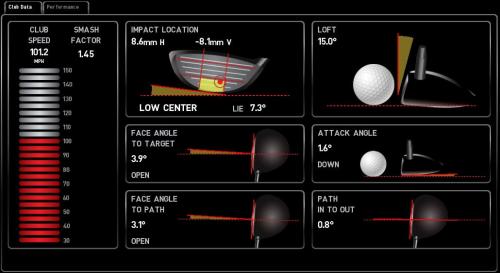

See last shot in the table. This gives us a bit of a clue. This ball went dead straight according to Alex and actually struck the target the golfer was aimed at. Face angle at impact was 3.1 degrees open to the path with a slight heel contact.
Another straight shot

If clubface is closed by 2.5 degrees to the path and contact on the toe, the ball should hook right? Well this one was a one yard draw. See last shot in table below. But this golfer has a low rate of closure plus toe contact offsets the closed face to path (which normally would cause a draw).
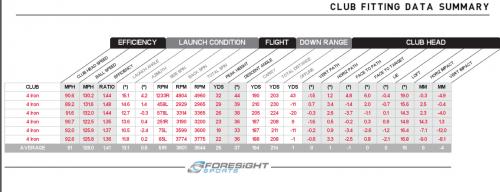
What are we balancing?
If you believe staticicians, zeroing out your path is the goal. In other words having a square clubface to a square path will create a straight shot. But there’s something missing here.
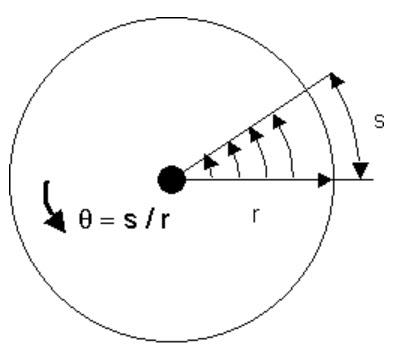
Angular velocity is faster the farther from the axis of rotation. So toe of club is traveling faster than heel just as the club will always move faster than the hands since it is farther from the axis of rotation.
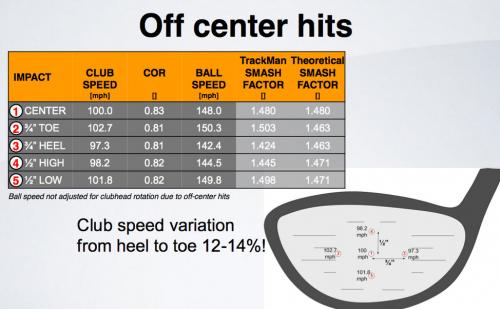
Trackman data shows the ball speed is higher on toe contact (due to higher clubhead speed on toe) despite lower COR. This will already bring a tendency toward an eccentric force being applied to the toe side of the ball or draw spin.
So the angular velocity effect is a given but then you have to add the shaft rotational motion that is a major factor in creating the clubface closure rate. Variations over 5000 degrees per second are possible and of course there are players that have a negative closure or opening rate (but let’s leave them out of discussion for now).
Thus, when the faster moving toe of the club meets the ball, the toe side edge of the ball will deform first and more than the heel. The faster the toe is moving than the heel of the club, the more deformed the toe side of the golf ball will be thus creating higher potential for draw/hook spin.
In other words the higher the rate of closure and the higher the clubhead speed, the more deformed the toe side of the ball will be……..all things being equal. This could explain why better golfers generally have to fight the hook.
With this in mind, the straight shot is not struck with a square face to the path (given center contact). It must be open to the path. How much you ask? It’s not that simple. Remember there are all those other factors? But let’s just say for simplicity sake that it should be around 1 to 2 degrees open to the path for someone with a low rate of closure. For someone with a higher rate of closure it would be two or three times more. For someone with a negative rate of closure, the clubface could be closed a few degrees depending on how low/high the rate is.
For off center hits, toe contact will slow ROC and help those that have a tendency to hook. Heel contact will help increase ROC for those that tend to slice or fade.
So now does the Foresight data make more sense and why it is so hard to hit it straight? Straight shots are struck with an open face to the path with high rate of closure! For someone with extremely low or negative rate of closure, the clubface needs to be slightly closed.
ROC and Ball Deformation
Understanding weak fades and slicers is easy. They don’t have enough of a rate of closure to create an eccentric force on the toe side of the ball thus have an inability to hit it straight. Their eccentric force is easy to understand. The clubface is too open in relation to the path given their low rate of closure thus an eccentric force to the left side of the center of the ball is created thus a slice/fade occurs.
But for anyone that can swing over 95 mph and get the clubface square at impact occasionally, understanding why the ball goes left or right/draw or fade is quite a challenge especially when small changes in any of the variables during the impact interval can change the eccentric force direction.
ROC Variability
And ROC is not a constant for anyone. Even pros have different ROC for different clubs. That’s what makes them better for short irons vs driver like Phil Mickelson (massively rolling on his driver vs drive/holding short irons) or better drivers of the ball vs short irons like Gary Woodland (rolls his irons while drive/holding his driver).
Also, there is swing to swing ROC variability that is a given for each player. Humans are not robots regardless of how we practice so hard to build a repeatable swing. One can get excited, nervous, tense or anxious and this will surely affect your ROC.
ROC and finger roll
When a basketball player does a little finger roll on a layup off the backboard, doesn’t he do this as he releases the ball? Doesn’t this mean that all hand movement while still touching the basketball potentially alter the spin? So it is with a golf club. Every movement in the half millisecond contact time will have an effect on the spin, spin axis (therefore curvature) and ball launch direction.
Check out this kid. You can hear in the video the thumping sound when he is accelerating the spin by striking the ball.
This means there is a slight compression (or direct hit), then a stretching of his skin and/or the basketball’s cover and then a tangential swipe of the ball.
This makes total sense to me. I’m sure if I could Phantom video this kid, this is what we’d see.
So does it make sense to have the clubface rotating as fast as possible?
This is a 30 yard hook with a 7 iron from a flip/roller.

Statically, it’s just a slight bit closed.

Dynamically, max compression shows the eccentric force. Despite slight toe contact, more toe side deformation causes ball to start left of actual face angle. If the clubface continues to rotate, more hook spin or finger roll action is applied.
Dynamic Path Changes Combo
Here’s dynamic path shift video again.
If a path shift to the right makes for a bigger hook, then a path shift to the left will cause a slice. But on a smaller scale this also means that better players with hooking problems could use this path shift as a means to counterbalancing the hook a la “swinging left.”
This means that every movement of the path during the impact interval matters quite a lot. It just adds to the complexity doesn’t it?
Contact location
- Toe will push
- Drive/holders will tend to miss toward toe and this helps to slow the rate of closure.
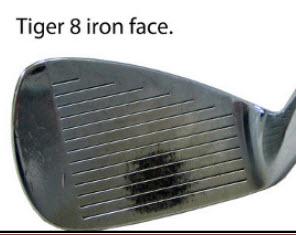
From the sandtrap.com. Notice wear spot is slightly toward toe of club. -
Here’s closed face at impact toe push fade - Path can even be moving left and struck on toe, ball can start right.
- Drive/holders will tend to miss toward toe and this helps to slow the rate of closure.
- Heel will pull
- Rollers, flip/rollers will tend to hit toward the heel as compensation for a clubface that is slightly too open just prior to impact. This helps to increase closure rate. Tough part of this method is heel shots will lose distance as that part of the clubhead is moving slower than toe.
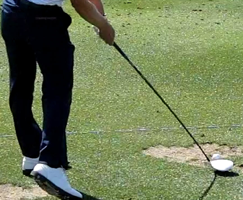
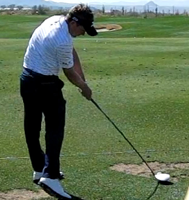
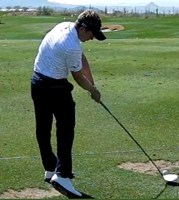
Here’s Luke Donald hitting each shot on heel.
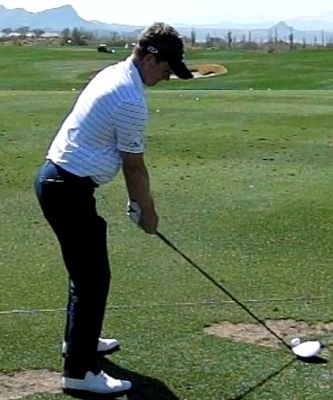
He even sets up at address to strike it on the heel.
Deciphering Ball Flight
How did a tour pro pull hook it?
For many golfers, even television announcers, shots that go left or pull draw/hook are blamed on “coming over the top.” “He got quick and came over the top of that one” the golf analyst will say. Are these guys saying that PGA tour players with fantastic repeatable swings are actually swinging over the top from time to time??? I don’t think so.
If you buy into this notion (which comes from old ball flight laws), what do we learn from this? Every time you pull hook it is a reminder to swing your path more to the right.
The hip golf analyst will see the ball pull hook and say, “He turned it over too quick.” This “informed” announcer knows that the ball will fly 85% in the direction of where the clubface is pointed (new ball flight laws). Thus every pull hook is a reminder to do what? Leave the face more open?
But are all pull hooks created similarly?
Draw/Hooks
If there is more toe side ball eccentric force and a path right, there will be two possible ball flights:
- Push draw if low ROC
- Can pull draw/hook if high ROC or path shifts right on collision
- https://www.youtube.com/watch?v=hw3BFLQ0WYA
- Heel contact (as in our earlier Foresight HMT example)
If there is more toe side eccentric force and path left:
- Pull draw if low ROC
- Pull hook if high ROC
- Push draw if toe contact
If you’re paying attention, there are several ways to hit a pull hook. How do you know which one afflicts you? Can you see if a golfer’s hook is caused by path/path shift or high clubface closure rate with high speed video? Sure you can!
It’s probably too much to ask a golf analyst to determine what really caused the pull hook on the fly. This would take some time and zoomed in Swingvision camera on the shot plus multiple camera angles to really be sure. So we’re left with just a bunch of anecdotal sayings that give you the impression that all pull hooks are created the same way.
Fades/Slices
If there is more heel side eccentric force and path right the shot will be a:
- Push fade if low ROC
- Push slice if negative ROC
If there is more heel side deformation and path left:
- Pull fade if low ROC
- Push slice if negative ROC
So how does it happen? How about an increase in rate of closure? How about a heel contact? Or a path shift to the right.
The obvious answer to the pull hook is that the path is left and clubface closed. But knowing what we know, here are three of the many possibilities.
- High closure rate with path straight, clubface open and center contact
- Medium closure rate with path straight and heel contact
- Low closure rate with path straight but clubface closed
For players with high closure rates or clubhead speeds, the clubface needs to be open to the path in order to hit it straight and learn to decrease closure rate through impact.
Release pattern
In the end, doesn’t it all come down to this? The golfer is moving the club in a fashion that produces a club movement that ultimately controls the collision.
This it Tiger Woods from the Honda Classic 2014. He was struggling with hitting pull draws and weak high fades. His release has a lot of roll in it (right forearm pronation/left forearm supination) and barely escapes an underflip (right wrist flexion) by one frame. Could this be another reason he’s struggling?
This Tiger from 2012 when he was winning tournaments. He had a lot more stable release without right forearm pronation or anywhere near the amount of right wrist flexion.
We can try to control the release style as best we can since that is ultimately the skill of playing golf. Tour pros whether they realize it or not already control the clubface, path and contact location as best they can. That is, unless they are listening to highly questionable static data that will drive them confuse them to the highest degree.
The reality is that the impact interval is complex and dynamic. Controlling the variables (release patterns) that are under your control is what this game is all about.
Real Ball Flight Laws
Since there are so many troubling issues with static vs dynamic issues, the gear effect and even its validity/implications, club construction differences (non-uniform density, COG location, face bulge/roll), it would be better to start from scratch rather than continue with modifying “new ball flight laws.”
We could start by looking at the ball deformation and eccentric force applied to the ball. Initial observations appear to show that the ball starts in the direction of eccentric force not where the face is pointed.
Then start to break down major variables like rate of closure and dynamic path in order to understand how horizontal spin is created. The interplay between rate of closure and dynamic path is critical to understanding the fundamental face-to-path relationship that creates the eccentric force in the first place.
Once that is done then we could try to look at the unknowns like the deformation of the driver face and corresponding rebound direction.
It is unlikely that there is a simple solution. The reality is that this is complicated beyond anyone’s imagination.
Tour Pros Caveat Emptor
Oh and by the way, Ki Tora was just a metaphor for Tiger Woods. Besides back surgery, he has to overcome static information instead of relying on dynamic information to better his game. Also, his release style has evolved as you can see. And his driver release is looking more like Mickelson’s fast roll. At this point in his career, there’s no time to waste listening to static data that is questionable when one can clearly see dynamic issues with a Phantom video camera (which Tiger can easily afford).
After all, if a $30,000 machine can’t present all the complex information needed to understand real ball flight laws, electronic toys like these gyros, accelerometers have virtually no hope in getting this right either. Sample rates are too low and error margin too high. I tested a Swingbyte2 vs. the Phantom and the errors are huge.
For teachers wanting an affordable high speed camera option, the Edgertronic High Speed Camera is available for around $5500 with global shutter (means no line scan distortion which older iphones have that make the club bend like a garden hose) and up to 18,000 frames per second (though at lower resolution). This is plenty enough camera to see bumble bees fly.
For those interested in weight shift, force plates, COM and COP read this great article by Doug Marsh. http://www.clubmakerscalculator.com/golfbiomechanics/ You will find that his findings are right in line with what I’ve been seeing from the great players.
Congratulations to Sam Chien of San Diego! After visiting Hawaii in March, he’s won a PGA tour China event and a Gateway Tour event. He’s the leading the order of merit in the race to the Web.com tour. http://www.pgatour.com/pga-tour-china/news/2014/05/04/pgatourchina-samchien-buickopen.html

